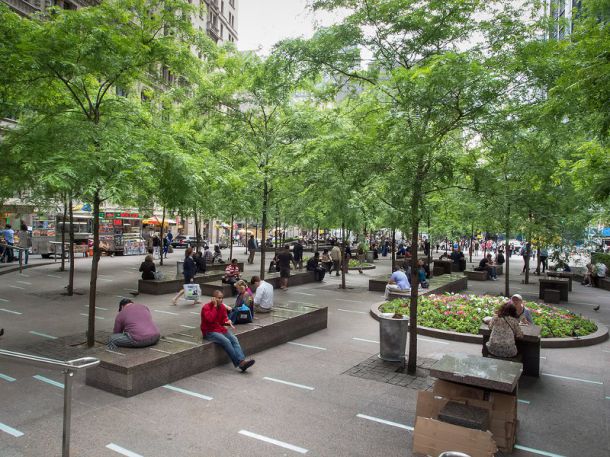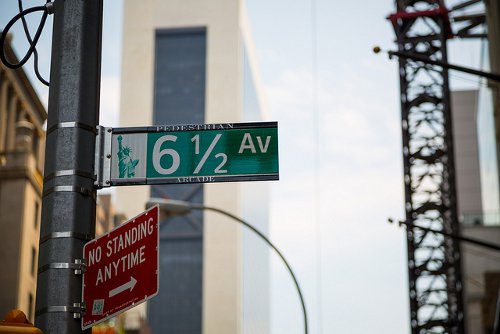
In New York City, boundaries can affect everything. The price of your apartment, the prestige of your address, and the school your children go to all, in the end, rely on location.Equally, what you can do in that location comes down to ownership. Is that cheap office in Tribeca somewhere you could live? Not if the zoning is wrong. That great apartment complex – can they really deny your application based on politics? They can if it’s a co-op. And your favorite park playground – do they have to close at dusk? If they’re publically owned, they probably do. But what if they’re privately owned? Or, without it being a contradiction in terms, a privately owned public space? Welcome to the world of POPS.POPS were brought into NYC through a 1961 zoning resolution which offered businesses and developers zoning concessions in exchange for providing and maintaining publically accessible spaces. Now, over 500 POPS exist throughout the city – with most being centered in Manhattan. Though previously a little known feature of many neighborhoods, POPS gained widespread media attention after Zuccotti Park was chosen as the base for the Occupy Wall Street protests last year. As a privately owned park it was beyond the jurisdiction of the city government and the curfew laws which applied to other public spaces. The protestors were able to remain in the park throughout the night and only once they were forcibly removed – with the consent of the park’s true owners, Brookfield Office Properties – was the park shut.A Space to Call Your OwnFinding somewhere to rest – for free – in NYC can be a true challenge. A space which is covered, of a certain quality, and open to all might seem too much to ask, but a working knowledge of the POPS in your area can grant you access to often vibrant spaces and their many uses. The recent MAS Summit for New York City brought attention to the creation of an urban environment which supports both economic growth and a sense of place and community. Public knowledge and understanding of POPS is somewhat patchy, and the spaces may at times appear almost exclusive, or secret, but the reality is far different; POPS are yours to use, to relax in, to enjoy, and to share with others.You can find a map of the city’s POPS on the nyc.gov website. The style of POPS can vary, from widened sidewalks to arcades, from enclosed public plazas to publically-accessible lobbies. Though owners are permitted to impose “reasonable” rules to regulate behavior and sanitation in these areas, access to the sites and free usage are paramount, and the responsibility for upkeep rests firmly with the owners. However, a lack of clarity on the specific rules which apply to public spaces in private hands – especially in a post-Occupy world – means that the entire project is currently being reviewed. As the city government admits, “In response to the perceived failure of many of these spaces and to community opposition, the types of spaces permitted and their locations have been curtailed in recent years.”Untapped New York has a good photographic record of a variety of POPS, and again highlights the stark difference between the quantity and the actual quality of many POPS sites. Still, there are many well maintained POPS and further improvements are just around the corner.

Friends of POPS, a community group seeking to promote and protect the correct usage and required upkeep of New York POPS, acted as a liaison between the various owners and official bodies invested in the future of POPS. In September 2012, the midtown pedestrian plaza of “6½ Avenue” opened. It connects six POPS through newly constructed crosswalks, and allows pedestrians to cut between 51st and 57th Street mid-block. Developed by the Department of Transportation, this pedestrian thoroughfare hopes to serve some of the 1200 New Yorkers an hour who previously crossed midblock to access the plazas. With its own street level signage and even recognition on Google Maps, 6½ Avenue well represents POPS – streamlined access and real funding on a government level.For more information on the past and current state of POPS, see Privately Owned Public Space: The New York City Experience, a publication based of the collaboration of The Department of City Planning, the Municipal Art Society, and Harvard professor Jerold S. Kayden. The book features profiles of all 503 privately owned public spaces, and is available on Amazon.Who Uses POPS?Privately owned but publically available spaces operate in a confusing area of NYC politics. Though some are easily accessible and widely used – atriums, parks and sculpture installations – others remain little known, difficult to access and – as private property – heavily monitored and regulated. Official sources have acknowledged the mixed results of the program:“An impressive amount of public space has been created in parts of the city with little access to public parks, but much of it is not of high quality. Some spaces have proved to be valuable public resources, but others are inaccessible or devoid of the kinds of amenities that attract public use. Approximately 16 percent of the spaces are actively used as regional destinations or neighborhood gathering spaces, 21 percent are usable as brief resting places, 18 percent are circulation-related, four percent are being renovated or constructed, and 41 percent are of marginal utility.”Equally, crowd-sourced studies of the 503 POPS seeks to make clear the best and the worst of the often varied sites. Though many POPS are architecturally stunning and well presented, others may well be little more than the price developers will pay to be able to build taller buildings in Manhattan.The question, though, may well not be “who uses POPS,” but “who can use them?” The answer, of course, is – everyone. From the smaller sidewalk “parks” to the grand, furnished atria of hotels, to Jazz at Lincoln Center, privately owned public spaces can seem deceptively private, but in reality they are free and open to use.

